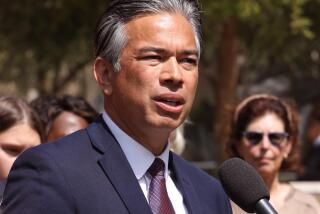Judge Orders Release of Adjusted Census Data
- Share via
SACRAMENTO — A federal judge has ordered the release of adjusted census data that includes an estimated 1 million Californians overlooked in the official U.S. Census taken in 1990.
If the order, issued Tuesday by U.S. District Judge William B. Shubb, withstands appeal, the data would go to the state Legislature, which could try to use the numbers to redraw the state’s political boundaries before the 1994 elections.
The 120 legislative and 52 congressional districts were just redrawn by the state Supreme Court--without the benefit of the adjusted data. The court drew the districts to break a stalemate between the Democratic-controlled Legislature and Republican Gov. Pete Wilson.
Under state and federal law, each Assembly, Senate and congressional district must be redrawn every 10 years to contain, as nearly as possible, the same number of people as every other district of that type.
But minority activists and Democrats contend that many of the newly drawn inner-city districts actually contain more people than they should because many homeless, illegal aliens and others were not counted by the census-takers.
The revised data, compiled by the Census Bureau to estimate the so-called “undercount,” has been kept under wraps by the Commerce Department. The department has said the adjusted figures are no more reliable than the original count.
If the higher numbers were used to draw the districts, they would be expected to produce relatively more districts in urban areas and fewer in suburban and rural communities. This would favor Democrats and possibly lead to the election of more ethnic minorities.
Attorneys for the federal government said they would appeal the ruling.
Joseph Remcho, the Assembly’s lawyer, said even if the Assembly prevails it will be too late for the adjusted numbers to be used for this year’s elections.
Arturo Vargas, director of policy for the Mexican-American Legal Defense and Educational Fund, said the judge’s decision was “great news.” MALDEF has a separate case pending to force the Legislature to use the adjusted numbers if they can be obtained.
“What this will show is that the minority districts (drawn by the state Supreme Court) are severely overpopulated,” Vargas said. “Our position would be that the state should employ the adjusted data before the June elections.”
Another case pending in New York would force the federal government not only to release the adjusted numbers but to use them to reallocate the 435 seats in Congress and adjust various formulas that fund federal programs based on the population of each state.
More to Read
Get the L.A. Times Politics newsletter
Deeply reported insights into legislation, politics and policy from Sacramento, Washington and beyond. In your inbox twice per week.
You may occasionally receive promotional content from the Los Angeles Times.










